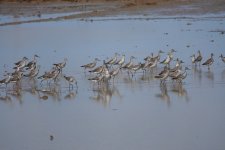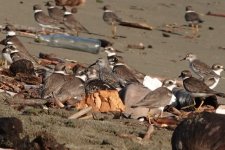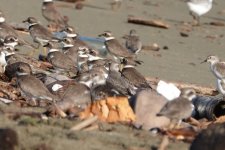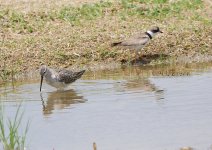Hello. I have this birding spot in the north coast of the Dominican Republic where I observe shorebirds. The problem is sometimes there are so many hiding in beach debris that I have to take photos as to get a better assessment of species present. Many times I find 3 to 4 species missed from photos. I have one bird that I am not sure if it is a Western Sandpiper or a Dunlin and I only found after looking at photos. Not the greatest photo as it is cropped from larger image. The bird in question is in center to the right of the Ruddy Turnstone (ebird checklist S122554020). Any help would be greatly appreciated.
-
Welcome to BirdForum, the internet's largest birding community with thousands of members from all over the world. The forums are dedicated to wild birds, birding, binoculars and equipment and all that goes with it.
Please register for an account to take part in the discussions in the forum, post your pictures in the gallery and more.
You are using an out of date browser. It may not display this or other websites correctly.
You should upgrade or use an alternative browser.
You should upgrade or use an alternative browser.
Western Sandpiper or Dunlin (2 Viewers)
- Thread starter mcdunn
- Start date
More options
Who Replied?Steve Lister
Senior Birder, ex County Recorder, Garden Moths.

Looks like a Dunlin to me. What is the other Calidris to the right?
The other Calidris is a Semipalmated sandpiper (I believe). In second photo you just catch a bit of a Sanderling.Looks like a Dunlin to me. What is the other Calidris to the right?
Steve Lister
Senior Birder, ex County Recorder, Garden Moths.

Maybe you are right. I thought it looked bigger than your interpretation, and also that the tip of the bill was hidden behind the Turnstone's head.Looks too small for dunlin (it's about the size of the semipalmated plovers and the semipalmated sandpiper at right). American dunlins tend to have stupidly-long bills rather than this sort of length. So...
birdmeister
Well-known member

I would have said Dunlin for the center bird. I think the bill is long enough, and most of the other plumage characteristics fit. I think a Dunlin would not appear much bigger amidst a flock of Semi Plovers.
tom baxter
Well-known member
That is a very strong supercilium for a Dunlin. I agree that it appears quite small for Dunlin as well. Not sure what else it could be though...
Thank you all for the insights. The observation of this bird was made during the period we get migrants that are passing through or staying here during the northern winter (11/17/22). Birds arriving here are really skinny. Dunlins, however, are rare in the Caribbean (only 3 ebird sightings for the Dominican Republic). I had not considered the Curlew Sandpiper which I believe is slightly smaller, but again, a very rare bird in the Caribbean (no sightings in the Dominican Republic). What would one look for in discounting Curlew Sandpiper in nonbreeding plumage?
No! - because I always forget they existHave you considered Stilt Sandpiper?
Would explain the rufous ear-coverts.
I think it is too small for a Stilt Sandpiper. Here is a photo I took recently of Stilt Sandpipers (4th bird from right and one below 7th and 8th bird from right) with Lesser Yellowlegs (https://ebird.org/caribbean/checklist/S126862595).



tom baxter
Well-known member
Wow, I never thought of these two as being in a similar size class, but it is a compelling explanation here. The bill of the question bird does look pretty good for a Stilt Sandpiper. I’m inclined to buy that. Nothing else makes more sense in my opinion.Here is a photo showing Stilt Sand with Semi Plover. Notice the plover is behind making it look a little smaller.
View attachment 1491663
Semi Plover weighs about 47 grams, Stilt Sand from 50-70 (data from birds of the world). That means that the body size of a smaller Stilt Sand is about the same as the plover.
Niels
Steve Lister
Senior Birder, ex County Recorder, Garden Moths.

I still favour this being a Dunlin but it is interesting how different people see different things in the photos, especially as regards size. To me it looks a Dunlin-sized bird relative to the Semi-p Plovers (assuming they are Ringed Plover size) so that would suggest it is too big for a Western. Yet to others it looks the same size as the Semi-p Sandpiper - that would surely rule out Stilt Sandpiper which is quite a big bird.
AveryBartels
Well-known member
I would tend to agree that this bird seems to small for a Stilt Sandpiper, also they are quite long legged so I would expect one to be noticeably taller than the surrounding species, unless it is standing in a hole 

True, but they tend to seek out spots with deeper water ...I would tend to agree that this bird seems to small for a Stilt Sandpiper, also they are quite long legged so I would expect one to be noticeably taller than the surrounding species, unless it is standing in a hole
Niels
AveryBartels
Well-known member
True, but that is a more relevant trait when in water rather than on land (as in these pics) 
Users who are viewing this thread
Total: 3 (members: 0, guests: 3)







